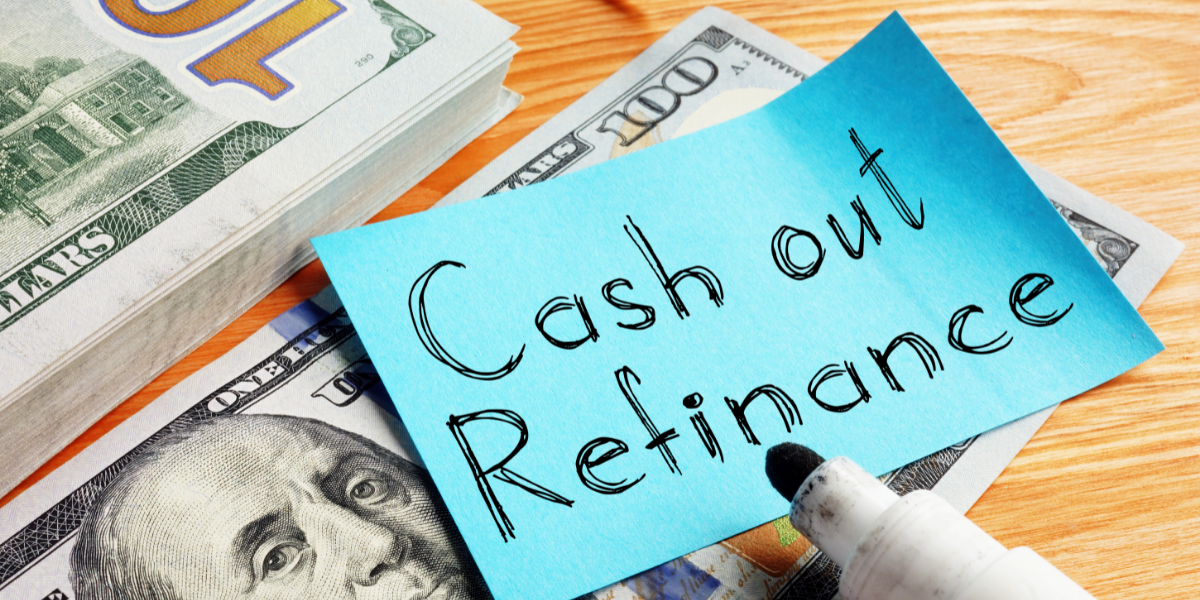Most people looking to lower monthly mortgage payments, reduce interest rates, or eliminate private mortgage insurance (PMI) often consider cash-out refinancing. However, a cash-out refinance can also be an effective method for real estate investments.
With more than a 15% increase in home values and mortgage rates at historic lows, it’s an excellent time for real estate investors to take the equity in rental properties and “cash out.”
In this article, we will discuss the basics of a cash-out refinance, how it works, and how to consider if it’s right for you.
What Is a Cash-Out Refinance?
A cash-out refinance is a refinancing option that allows you to withdraw money from the equity in your home. This process pays off the original loan and replaces it with a new loan that has a new interest rate and term.
The new interest rate can be fixed or adjustable depending on the type of loan, a cash-out refinance. The loan terms and money you receive depends on elements like credit history, investment experience, and the appraised value of the home or property.
The portion of equity you choose to take out is added to your new mortgage principle. Refinance money can boost savings, consolidate debt, or make home improvements.
It’s important to note that you don’t instantly get the cash from refinancing. Once you decide to go through with a cash-out refinancing, you must have your home appraised, go through the underwriting process, and have the lender’s approval.
After closing on the new loan, you have three days to cancel the loan. If you do not cancel, you will receive the cash three to five days after closing.
Strategic Facets of Cash-Out Refinance
A cash-out refinance is a reflection of an individual’s approach to wealth building and financial management. It’s one (of many) strategies you can use to build your investment plan.
By understanding the deeper motivations and strategic outlooks that drive these decisions, you can make more informed choices about your financial journey.
Here’s what to consider:
- Financial Fluidity vs. Static Wealth: Homes are often the most significant assets people own. But while the value tied up in a house represents wealth, it’s static. Cash-out refinance is one method to convert static wealth (home equity) into fluid assets (cash), which can be strategically maneuvered for various purposes.
- Risk Tolerance and Opportunity Recognition: Those who opt for cash-out refinances often see opportunities that others might not. They might recognize potential investments, businesses, or other ventures that can generate a return higher than the interest on their refinance. This indicates a higher risk tolerance and an entrepreneurial mindset.
- Holistic View of Debt: The modern financial environment has reframed how many view debt. Instead of seeing all debt as bad, there’s a growing acceptance of “good debt” – debt that is used to generate higher returns or improve one’s financial position in the long run. A cash-out refinance can represent this nuanced perspective on borrowing.
- The Temporal Value of Money: The principle that money available today is worth more than the same amount in the future (due to its potential earning capacity) underpins the idea of a cash-out refinance for many. Instead of waiting for a home to appreciate slowly over decades, pulling out equity now can provide immediate funds for opportunities that might yield faster or more significant returns.
- Life Stage and Goal Alignment: As homeowners move through different life stages, their financial goals shift. Younger homeowners might see a cash-out refinance as a way to fund startups or invest in aggressive ventures. Those in middle age might use it for diversifying their investment portfolio, while older homeowners might use it to enhance their retirement or help the next generation.
- A Counter to Economic Inflation: With rising inflation, money today might have more purchasing power than it will in the future. By taking out equity now, homeowners can invest in assets or opportunities that might better keep pace with or exceed inflation rates.
Pros and Cons of a Cash-Out Refinance in Real Estate
Before pursuing a cash-out refinance, consider both the immediate benefits and the long-term implications. Consulting with financial professionals can provide clarity on whether this is the right move based on your financial circumstances.
Pros of a Cash-Out Refinance
- Liquidity: This is one of the most attractive features of a cash-out refinance. Homeowners can access a significant amount of cash based on the equity they’ve built in their home.
- Lower Interest Rates: If mortgage rates have fallen since the homeowner first took out their original mortgage, they may be able to secure a lower rate with the refinance, which can lead to lower monthly payments.
- Debt Consolidation: Homeowners can use the cash from the refinance to pay off higher-interest debts like credit card balances, personal loans, or student loans, potentially saving money over time.
- Home Improvements: The funds can be used to finance home improvements, which might not only enhance the living experience but also increase the home’s value.
- Tax Deductible Interest: The interest paid on mortgage debt, including cash-out refinance, is often tax-deductible, whereas the interest on other types of debt, like credit cards, is not.
Cons of a Cash-Out Refinance
- Closing Costs: Refinancing a mortgage typically comes with fees and closing costs, which can range from 2% to 6% of the loan amount. These costs can eat into the amount of cash you receive.
- Longer Mortgage Term: If the homeowner chooses a longer loan term than their original mortgage, they could be paying off their house for a more extended period.
- Higher Interest Cost Over Time: Even if the new loan has a lower interest rate, extending the term of the loan might result in more interest paid over the life of the loan.
- Reduced Home Equity: A cash-out refinance reduces the equity the homeowner has in the property. If the housing market experiences a downturn, there’s a risk of owing more on the house than it’s worth.
- Risk of Foreclosure: As with any mortgage, if the homeowner can’t make their payments, they risk foreclosure. By borrowing more, homeowners might find the new payments challenging to manage if they face financial hardships.
- Potential for Misuse of Funds: While many use the funds from a cash-out refinance wisely, there’s always the risk of misusing the funds on non-essential items or poor investments, leading to more significant financial issues in the future.

Reasons to Consider a Cash-Out Refinance Loan Program
What makes it an excellent option for real estate investors to consider?
When an investor pays off an existing mortgage using new loan terms, the cash difference is theirs to keep. This cash becomes a new source of capital to either make property improvements or purchase a new property.
Here are a few common reasons real estate investors choose a cash-out refinance.
Tax Benefits
One of the most significant advantages of cash-out refinancing for real estate investors is the tax deduction. The interest on a cash-out refinance is tax-deductible, as are most of the closing costs and others associated with the transaction. Unfortunately, investors often do not relish this benefit when borrowing money from banks or private lenders.
Favorable Loan Terms
Mortgage rates and terms are much better than interest rates from bank loans. Cash-out refinance loans have better interest rates than home equity loans. When directed toward real estate, this type of refinancing can save thousands. Additionally, there are fixed-rate and adjustable-rate options, making it easy for investors to find the best option for their situation.
Flexibility and Speed
With a cash-out refinance, the money can be used for various purposes. As a real estate investor, this means adding more capital. Additionally, cash-out refinances offer investors a quick start to accumulate the financial resources they need to make deals.
Although there are several benefits to a cash-out refinance, it’s essential that you know the rules. There are specific guidelines from Fannie Mae if you want to pull cash-out of rental properties.
- Properties can’t be for sale during the cash-out refinance process.
- Most properties purchased within a six month time frame are not eligible for cash-out refinance.
- Properties listed for sale within the previous six months must have a maximum loan-to-value (LTV) of 70%.
- Maximum 75% LTV for single-family homes or one-unit properties.
- Maximum 70% LTV for 2- to 4-unit properties such as a duplex or triplex.
- Adjustable-rate mortgages must have LTVs of 65% for one unit and 60% for 2 to 4-unit.

How Cash Out Refinance Works for Real Estate Investors
The cash-out refinance process for real estate investors is generally the same as it is for primary homeowners.
If you need a refresher, here are a few common reasons why it’s difficult to get a loan.
However, real estate investors need to follow certain steps.
Step 1: Proper Documentation
Proof of Income: You may need to prove your income depending on the situation. If required, you’ll have to show the lender pay stubs from the last month. They may also want to see bank statements and other forms of income verification.
W-2 or 1099 Forms: These forms help lenders verify employment history and income. Self-employed people will need copies of a full tax return.
Homeowners Insurance: Proof of homeowners insurance is required to show that you have enough coverage on the property to protect the investment.
Title Insurance: This ensures the lender that the property or home in question is yours to refinance. It also gives a legal description of the home or property and tax information.
Asset Information: As an asset-based loan, a cash-out refinance means you’ll have to show copies of the borrower’s assets, things like investment accounts, retirement, savings, and bank statements.
Step 2: Apply
Although refinancing is typically less complicated than purchasing a home or property, you still have to go through the application and approval process. This process includes completing the lender’s application, submitting appropriate documents, and responding to all inquiries quickly.
Step 3: Lock in New Rates
Once your refinancing application is approved, you have the option to lock in your new interest rate. Before locking in your rate, take the time to read through the terms and consider all of your options. If you’re satisfied with the interest rate, you can lock it in. If you prefer to proceed with the loan and “float,” you can also do that.
Step 4: Underwriting
After locking in your new interest rate, you proceed with the underwriting process. During the underwriting process, a lender verifies the condition of a property and your documentation (income and assets). After verification, a home appraisal is ordered, which is an essential piece in determining a cash-out refinance.
An appraisal determines the fair market value of your home and shows your lender that the price you’ve agreed to pay for a home is appropriate. Appraisals are an effective way to estimate property taxes.
Step 5: Loan Closing
Once underwriting is complete and all documentation is approved, closing a new loan is the next step. Luckily, the closing process is much faster than traditional real estate closings.
You will receive a Closing Disclosure that details the new loan and all fees, including the closing costs. If all is correct, you will see the cash in your bank account within three to five days.
Benefits of Cash-Out Refinancing for Investors
- Leveraging Equity: Cash-out refinancing allows investors to tap into the equity they’ve built up in a property without selling it. This can provide liquidity necessary for other investments or expenses.
- Portfolio Expansion: The cash obtained from a refinance can be directly reinvested into other properties, allowing investors to expand their portfolio.
- Property Improvements: Investors can use the funds to make improvements to the property, potentially increasing its value or rental income.
- Diversification: The funds can be used to diversify investments, either within real estate (such as buying properties in different locations or of different types) or in other investment vehicles.
- Debt Consolidation: If an investor has other high-interest loans, the cash-out funds can be used to pay off those debts, leaving the investor with potentially more favorable loan terms.
Cash-Out Refinance Loan Programs for Real Estate Investors
A cash-out refinance makes sense for investors, individuals, or businesses with considerable equity in their property. This large sum of money can be used for business expenses, funding repairs, purchasing more investments, and more.
A cash-out refinance is often not the right choice, especially on a rental property. For instance, if the property will be sold soon, a cash-out refinance may cost more than you receive. Also, depending on why you need to cash, a cash-out refinance may not be the best option if you don’t have an immediate use for the funds while still paying loan fees.
The benefits are top-notch when done for the right reasons. You can lock in low interest rates, access maximum equity, and increase property values while generating more cash flow.
At Yieldi, we provide hard money loans to investors looking to cash out their equity quickly. For more information about cash-out refinancing or how to choose a loan program that’s right for you, our team can help!
Contact us online or give us a call! We’re more than happy to help!

